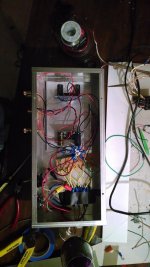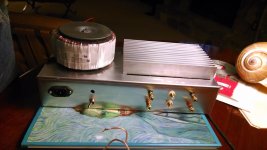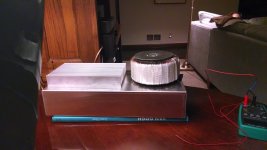Hi There,
I have spent some time pouring over the wonderful resources of this forum, the various referenced websites and the info rich application notes but I still feel a little lost and so I am starting this thread.
Background:
This Christmas I want to build a quality chipamp with my dad. He is an ex hifi sales man but still an audiophile at heart. After dropping out of an engineering degree at U of I he started a HiFi shop with some buddies in Champagne, IL that grew into a chain and eventually he wound up working as a head rep at Pioneer. A lot has changed since then but I owe my appreciation for music, and the quality reproduction thereof, largely to him. Much to my disappointment, over the years he has given away much of the premium set-ups away to friends and family (I'm most disappointed that the pair of Klipschorns and a La Scalla center with some beefy Crown amplification behind them never made it to my ears! )
)
But he managed to hold on to a pair of HPM-100's (the flashy dealer promo acrylic ones) that are being driven by a crappy off the shelf receiver.
Thus the need for a better amp and a good father son project has fostered this idea in my head!
My Question:
Of the plethora a of design options out there what would be a good pair with the HPM's? I've read everywhere that I should start with a proper LM1875 or LM3886 Gainclone but I want something that can drive those 12" woofers and make them kick from a quality Led Zepplin recording to a wonderful Brahms offering.
My electronics experience is limited (mostly RasPi and Arduino stuff) but I am a quick study and familiar with basic circuit design and my dad is quite competent.
After pouring over the LME series it seems like the 49830 driving some Mosfets may seem like a good option however all the projects surrounding them seem to spare no expense and really go for the gold in terms of circuit complexity (enough snubbing and decoupling caps to make my eyes cross ) and a bill of materials a little outside my price range.
) and a bill of materials a little outside my price range.
If anyone could point me towards a good middle of the line project that would pair with the HPM's nicely I would be greatly appreciative.
PS I need to order the parts soon to be delivered to GA in time so speedy and pertinent responses would be much appreciated!!
I look forward to this wonderful community's help!
Thanks!
I have spent some time pouring over the wonderful resources of this forum, the various referenced websites and the info rich application notes but I still feel a little lost and so I am starting this thread.
Background:
This Christmas I want to build a quality chipamp with my dad. He is an ex hifi sales man but still an audiophile at heart. After dropping out of an engineering degree at U of I he started a HiFi shop with some buddies in Champagne, IL that grew into a chain and eventually he wound up working as a head rep at Pioneer. A lot has changed since then but I owe my appreciation for music, and the quality reproduction thereof, largely to him. Much to my disappointment, over the years he has given away much of the premium set-ups away to friends and family (I'm most disappointed that the pair of Klipschorns and a La Scalla center with some beefy Crown amplification behind them never made it to my ears!
But he managed to hold on to a pair of HPM-100's (the flashy dealer promo acrylic ones) that are being driven by a crappy off the shelf receiver.
Thus the need for a better amp and a good father son project has fostered this idea in my head!
My Question:
Of the plethora a of design options out there what would be a good pair with the HPM's? I've read everywhere that I should start with a proper LM1875 or LM3886 Gainclone but I want something that can drive those 12" woofers and make them kick from a quality Led Zepplin recording to a wonderful Brahms offering.
My electronics experience is limited (mostly RasPi and Arduino stuff) but I am a quick study and familiar with basic circuit design and my dad is quite competent.
After pouring over the LME series it seems like the 49830 driving some Mosfets may seem like a good option however all the projects surrounding them seem to spare no expense and really go for the gold in terms of circuit complexity (enough snubbing and decoupling caps to make my eyes cross
If anyone could point me towards a good middle of the line project that would pair with the HPM's nicely I would be greatly appreciative.
PS I need to order the parts soon to be delivered to GA in time so speedy and pertinent responses would be much appreciated!!
I look forward to this wonderful community's help!
Thanks!
Member
Joined 2009
Paid Member
A wonderful idea.
My advice is don't pressure yourself into having to achieve the result of a finished project over the holidays - the pleasure might be more in the journey.
For the best chance of having a finished project I would suggest looking for a pcb or a kit that you can buy. I don't know what you have as a starting point, but there's more than the amp needed - chasis (implies you may have some holes to drill), heatsink, power supply, connectors, earthing, volume control and perhaps if you wanted to use some really expensive speakers down the road a dc-output protection module (which you can buy as a ready built from eBay). There's quite a bit to do so trying to design from scratch is going to be a fair bit of work. I think you were well advised with the idea of straight LM3886 project.
I never built one myself but somebody more knowledgeable can likely recommend a good supplier - e.g. - these guys look good:
http://chipamp.com/lm3886-amplifier-kit/
You should phone them up and find out what else you need to make a complete project - such as a power transformer.
My advice is don't pressure yourself into having to achieve the result of a finished project over the holidays - the pleasure might be more in the journey.
For the best chance of having a finished project I would suggest looking for a pcb or a kit that you can buy. I don't know what you have as a starting point, but there's more than the amp needed - chasis (implies you may have some holes to drill), heatsink, power supply, connectors, earthing, volume control and perhaps if you wanted to use some really expensive speakers down the road a dc-output protection module (which you can buy as a ready built from eBay). There's quite a bit to do so trying to design from scratch is going to be a fair bit of work. I think you were well advised with the idea of straight LM3886 project.
I never built one myself but somebody more knowledgeable can likely recommend a good supplier - e.g. - these guys look good:
http://chipamp.com/lm3886-amplifier-kit/
You should phone them up and find out what else you need to make a complete project - such as a power transformer.
Last edited:
I agree with AndrewT here, Decible Dungeon The Decibel Dungeon Gainclone index page with links to all chip amp articles. is a great resource for beginners. If you haven't seen it yet, I highly recommend you do, lots of good info and tips, it will help avoid a lot of the typical rookie mistakes we all suffer in the beginning. I also agree with johnr66 that it's probably wise to start off with a simpler, smaller scale kind of project to get your feet wet and gain the necessary experience before moving on to bigger and better things.
Mike
Mike
Member
Joined 2009
Paid Member
+1 for keep it simple.
Just because it's a straight LM3886 doesn't mean it won't sound good. Sometimes the extra stuff doesn't bring enough benefit and we pursue the more complex ideas just because they are an interesting challenge.
I feel that a proven pcb set is definitely the way to go given your goals.
Just because it's a straight LM3886 doesn't mean it won't sound good. Sometimes the extra stuff doesn't bring enough benefit and we pursue the more complex ideas just because they are an interesting challenge.
I feel that a proven pcb set is definitely the way to go given your goals.
Last edited:
Sometimes the extra stuff doesn't bring enough benefit and we pursue the more complex ideas just because they are an interesting challenge.
Inverting the input to the chip with a buffer/inverter really improves the way it sounds, and a servo is simple to implement and reduces the probability of tears.
Thanks for all the replies! I think I am going to go with Peter Daniel's LM4780 kit
in a parallel configuration. Hopefully this will be a comprimise between a successful build and a high quality finished product..
DIY Chip Amplifier Kits, PCB's, Components and Information.
I'm going to power it with a :
Avel Y236750 330VA 25V+25V Toroidal Transformer | 122-640
and possibly upgrade and snubberize the reservoir caps with these:
Invalid Request
and the recommended 3.3 nF caps and 0.1 ohm resistors from daniel's PSU schematic (any part no.'s for those would be appreciated)
If anybody has any links to a easy to work with aluminum project boxes and a good Pot recommendation then I think the first project is in sight and it should be a whopper.
please correct me if I am missing the mark!
in a parallel configuration. Hopefully this will be a comprimise between a successful build and a high quality finished product..
DIY Chip Amplifier Kits, PCB's, Components and Information.
I'm going to power it with a :
Avel Y236750 330VA 25V+25V Toroidal Transformer | 122-640
and possibly upgrade and snubberize the reservoir caps with these:
Invalid Request
and the recommended 3.3 nF caps and 0.1 ohm resistors from daniel's PSU schematic (any part no.'s for those would be appreciated)
If anybody has any links to a easy to work with aluminum project boxes and a good Pot recommendation then I think the first project is in sight and it should be a whopper.
please correct me if I am missing the mark!
Member
Joined 2009
Paid Member
Inverting the input to the chip with a buffer/inverter really improves the way it sounds, and a servo is simple to implement and reduces the probability of tears.
A regulated supply, exotic parts, dual mono construction, rf-shielding and perhaps even the 'My Ref' .... I agree that there are gains to be made but for a newbie wanting to make a project with his dad over the Christmas break I honestly believe anything beyond a proven pcb kit would be a move in the wrong direction.
And a solid basic approach provides a good platform for the future, something to compare against at least.
Last edited:
I think this may be exactly what you're looking for...It's a complete kit, with a great manual, and you guys should have a lot of fun building it.
Akitika GT-101 Audio Power Amplifier Kit
Akitika GT-101 Audio Power Amplifier Kit
Hi,
My suggestion is to go a hibrid one with some from LME498xx familly.
With 12" driver you can go deep in bass region and a LM3886 based design can quickly reach the voltage excursion limit.
100% agree...
Completed Amp
Hi Guys,
Thanks for all the advice. As I mentioned I went with one of Peter Daniel's excellent LM4780 kits! There was a little mistake with wiring up the secondaries to the rectifiers and it lead to some exploding MUR8100's (oops ) but i wound up finding some full wave rectifiers at radioshack (actually sourced from Vishay so not so bad) and got them all hooked up and spitting out some consistent pulsed DC without any ringing that I could hear at least.
) but i wound up finding some full wave rectifiers at radioshack (actually sourced from Vishay so not so bad) and got them all hooked up and spitting out some consistent pulsed DC without any ringing that I could hear at least.
We opted for parallel configuration even though they are driving 8 Ohm loads we didn't have a balanced source and it will be nice to have the option to try it out with some less efficient 4 ohmers .
Anywho here are some pics of the final project. The sound is fantastic!! Clear and wonderful imaging! I finished it on NYE and we spent the night listening to our favorites and hearing them in new light, wonderful stuff.
I just ordered another kit. I'm going to to do this one more correctly. Two transformers (correctly wired) to the MUR860's and then work in some circuitry to switch between parallel and bridged using a a DRV134 to handle the SE to balanced conversion. I'll keep you guys posted!
Hi Guys,
Thanks for all the advice. As I mentioned I went with one of Peter Daniel's excellent LM4780 kits! There was a little mistake with wiring up the secondaries to the rectifiers and it lead to some exploding MUR8100's (oops
We opted for parallel configuration even though they are driving 8 Ohm loads we didn't have a balanced source and it will be nice to have the option to try it out with some less efficient 4 ohmers .
Anywho here are some pics of the final project. The sound is fantastic!! Clear and wonderful imaging! I finished it on NYE and we spent the night listening to our favorites and hearing them in new light, wonderful stuff.
I just ordered another kit. I'm going to to do this one more correctly. Two transformers (correctly wired) to the MUR860's and then work in some circuitry to switch between parallel and bridged using a a DRV134 to handle the SE to balanced conversion. I'll keep you guys posted!
Attachments
haha yeah, I know the correct option is 2 moderate transformers but I opted for 1 big 625VA mama for simplicity and cost's sake. Definitely gives the juice. And it seems like the LM4780's built in under-volt protection negates the need for soft start, no discernible clicks or pops on power up.
next build will probably sport 2 X 250VA's
next build will probably sport 2 X 250VA's
The LM4780 Parallel amp is a good choice for some sturdy clarity and it can be bridged if you double the number of LM4780's. See also Link to AN-1192.PDF See also BPA200.Two transformers (correctly wired) to the MUR860's and then work in some circuitry to switch between parallel and bridged using a a DRV134 to handle the SE to balanced conversion. I'll keep you guys posted!
- Status
- This old topic is closed. If you want to reopen this topic, contact a moderator using the "Report Post" button.
- Home
- Amplifiers
- Chip Amps
- first time chipamp for a discerning listener


